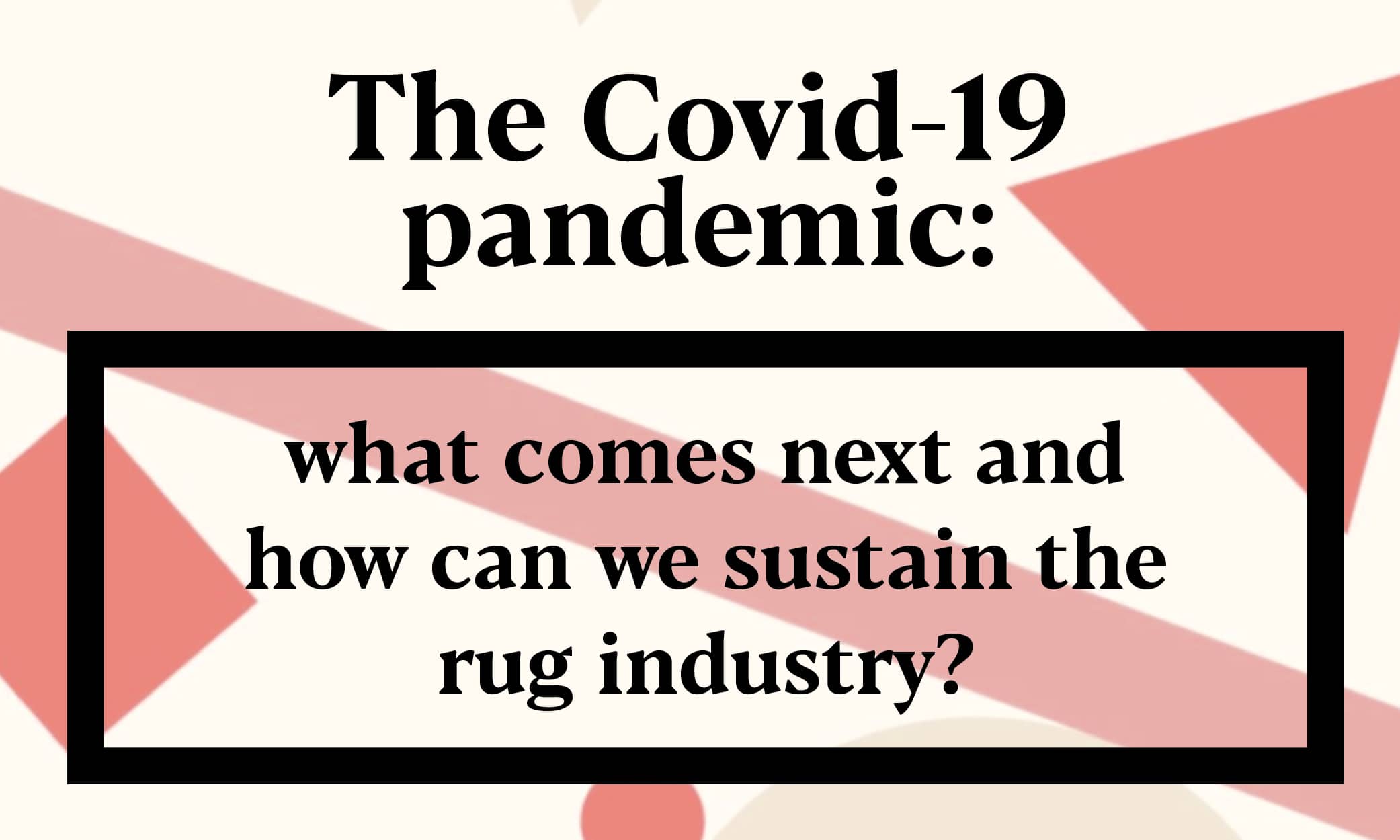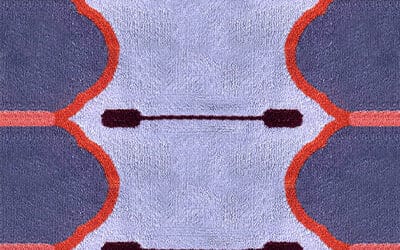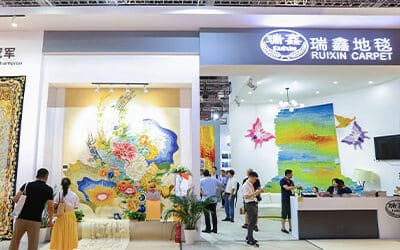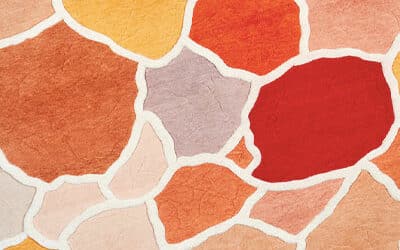My previous report about Covid-19 and the rug industry, which was posted on the COVER website in April, reflected how lockdown looked several weeks in. Now, as COVER 59 goes to press, we are on the other side of lockdown, with different parts of the world starting to open up again. Speaking to people in the industry, it is obvious that for many there is no greater clarity now on how business will be than there was two months ago—but we are certainly more impatient to get started. While there are some who are hopeful or expectant of big changes, the majority of people just want to return to some normality in order to survive financially.
Countries in Europe such as Germany and Denmark are ahead of the global curve, and life is getting back to a version of normal, and some states in America have been able to ease restrictions. We are at the very start of some retail stores coming back to life and interior projects being proposed, but many companies are expecting some slow months ahead. It is hard to tell what will happen in the immediate future.
Although everyone has had their own pandemic lockdown experience, for most people it has been a struggle, especially for those trying to run a business with no or little custom. Before the pandemic the rug industry was already in a state of change. The recent crisis is sure to bring greater urgency to problems that already existed.
Now we have seen what is possible without leaving the comfort and safety of our homes, I am sure the expectation for more and better virtual experiences will be here to stay. And virtual retail platforms will become even bigger news
Making decisions blind has become the norm. Among other issues, company owners have acknowledged that they do not want to lose their experienced staff members. The rug industry is a tight community of skilled people, the most skilled of which have to be the weavers.
Sadly it is the weavers who seem to suffer the most. The social and political context in which they live influences what is happening now. With little or no governement aid, supporting weavers and families in areas of Afghanistan, Nepal, India and Pakistan has been down to generous companies such as Amadi Carpets, Obeetee, Jaipur Rugs and organisations like GoodWeave and Label STEP. The Covid-19 funds started by the three latter organisations are still open for donations so please see the relevant websites for more details on how to help these causes.
Not only do the weavers and their families need to be fed and supported, but we need to ensure there is work for them going forward. Companies have a responsibilty to stand by their orders and keep demand up. Cancelled orders will only result in weavers being forced into other jobs, leading to a scarcity of labour and ultimately higher prices and longer lead times.
The weavers are the handmade rug industry‘s greatest asset—without them we simply don‘t have a beautiful product to sell and none of us wants to lose this history of craftsmanship. Now seems a good time to consider how we sustain our industry for the future, and the lives of our makers would appear to be a good place to start. In an article in COVER 57, I spoke to Matt Bourne of Christopher Farr about the rise in machinemade rugs. He commented, ’As weavers become more and more scarce as weaving countries industrialise there eventually will be no option of producing mass-market product except by machine.‘ We really have to face up to what effect coronavirus could have on handmade rugs and what our roles in shaping that are. What do we think should happen for the good of all?
With our fragile supply chain, the pandemic has created stasis in all areas of the industry. Not only has weaving been at a standstill but it has not been possible to get commissioned rugs out of weaving countries by plane, although it seems this problem is starting to ease in India but not Nepal. Sending rugs by boat is an option but this can take weeks and many people are just waiting for flights to open. This transport situation is set to cause issues for a while longer and, as I stated in my previous Covid-19 article, it may be that companies with high levels of stock are able weather this period better than some others.
Up until the current crisis, getting new designs and collections in front of customers relied on events such as design markets and rug shows, showroom visits and an online presence. Things are happening in terms of events: after nothing since March, IMC has plans to hold the Atlanta and Las Vegas Markets in August. Added to this, High Point is set for October, running over extended days to account for visiting restrictions; The Rug Show organisers hope to hold a New York event by the end of 2020, and the Domotex Hannover 2021 dates are set. Getting back to business is one thing, but many people worry about attendence levels and how to replace previous demand. For the first time in our lives we find it almost impossible to plan ahead; but we can put things in place that are sure to help.
The solution for many of these difficulties has been and will be online services. In a recent New York Times article titled ’Your Décor Is Ready for Checkout‘, Tim McKeough comments, ’The pandemic is pushing interior design consultations (and furniture sales) online, but companies were heading there anyway. The arrival of the coronavirus pandemic, however, changed everything. Within days of closing their stores, many furniture companies took a big digital step by putting robust virtual interior design services front and center.‘ Covid-19 just gave online an almighty push.
Virtual storytelling has become big news. During lockdown Nourison ran the firm‘s first virtual spring market experience online; Jaipur Rugs launched the Concoction Collection by Shantanu Garg on Instagram; design blog Dezeen held the world’s first online design festival; Sight Unseen ran the virtual exhibition Offsight Online; designer Matteo Cibic began working on a VR project; and the internet was full of online exhibitions and designer webinars. It is clear to see that, instead of settling for what they already had, companies that went above and beyond their normal web presence for this extraordinary time gained the most. It is not enough simply to be online: it is how you are online.
When I previously stated that decisions were being made blind this also relates to how the handmade rug world is on the whole rather behind other design industries in terms of brand development and communication in general. A reliance on shows and showrooms has become apparent in the lockdown. Going digital requires some commitment and also investment.
Now we have seen what is possible without leaving the comfort and safety of our homes, I am sure the expectation for more and better virtual experiences will be here to stay—and virtual retail platforms will become even bigger news across all industries. As the retail landscape changes, fair organisers are looking at how to introduce more virtual experiences for non-visitors. Of course, we must take into account that a large proportion of buyers of handmade rugs are sure to want to experience them in person one way or another. Physical fairs and showrooms will survive, but different buying options need to be considered.
Tap on the banner below to continue reading this article in the Free Digital Issue of COVER 59.





